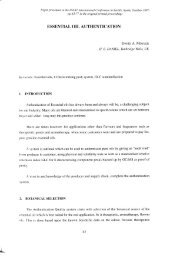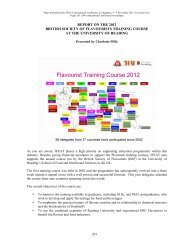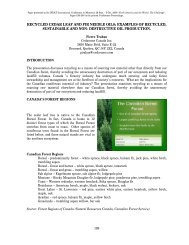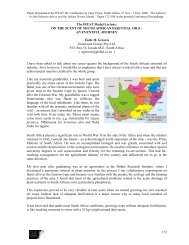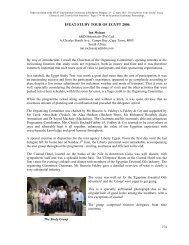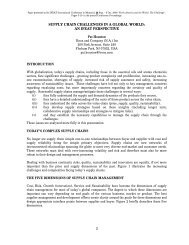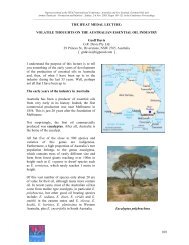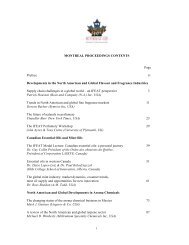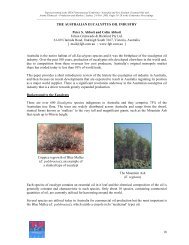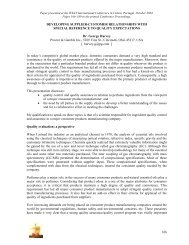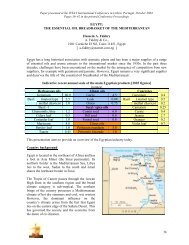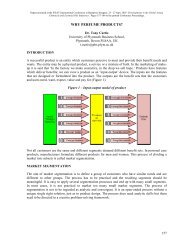time. The reasons for buchu oil’s <strong>in</strong>consistencies, however, become much clearer when its <strong>in</strong>itialhistory as a herbal remedy, and not a flavour and fragrance <strong>in</strong>gredient, is considered.The History of Buchu’s UseAs a medic<strong>in</strong>al herbBuchu has an ancient history as a n<strong>at</strong>ural herbal remedy <strong>in</strong> <strong>the</strong> San-Khoi heal<strong>in</strong>g culture. Traditionalceremonial and cosmetic uses of buchu as a body perfume <strong>in</strong> <strong>the</strong> form of dried crushed leaves mixedwith animal f<strong>at</strong>s have been documented. It is not known which species were employed but, due to <strong>the</strong>irpleasant aromas compared to o<strong>the</strong>r species <strong>in</strong> <strong>the</strong> Ag<strong>at</strong>hosma genus, A. betul<strong>in</strong>a and A. crenul<strong>at</strong>a arelikely candid<strong>at</strong>es.The modern history of buchu d<strong>at</strong>es from <strong>the</strong> 17 th and 18 th centuries when <strong>the</strong> Khoikhoi <strong>in</strong>troducedbuchu to <strong>the</strong> Dutch settlers <strong>in</strong> <strong>the</strong> <strong>Cape</strong> as a herbal remedy. Buchu’s purported medic<strong>in</strong>al uses causedits spread to Europe [10] and <strong>the</strong> first record of buchu export is by Reece & Co. who shipped driedbuchu leaves to England <strong>in</strong> 1821. By <strong>the</strong> l<strong>at</strong>e 19 th century large volumes of dried buchu plant m<strong>at</strong>erialwere exported to England and <strong>the</strong> USA; for example <strong>in</strong> 1873, imports were 153 tons by England and27 tons by <strong>the</strong> USA. Initially ‘buchu’ (of unspecified species) was ma<strong>in</strong>ly used <strong>in</strong> <strong>the</strong> form of<strong>in</strong>fusions or t<strong>in</strong>ctures and found widespread use as a n<strong>at</strong>ural health tonic for just about any afflictionth<strong>at</strong> affects mank<strong>in</strong>d, <strong>in</strong>clud<strong>in</strong>g rheum<strong>at</strong>ism, cholera, bladder diseases, stomach compla<strong>in</strong>ts, dropsy,dyspepsia, vesicle c<strong>at</strong>arrh, cystitis, gout, PMS and hypertension [10] .Advert for buchu <strong>in</strong> <strong>the</strong> Frankl<strong>in</strong> Gazette (USA), 1883105
It is <strong>in</strong>terest<strong>in</strong>g to note th<strong>at</strong> to this day buchu rema<strong>in</strong>s a well-known herbal medic<strong>in</strong>e <strong>in</strong> South Africaand to some extent <strong>in</strong> Europe. However, medic<strong>in</strong>al use today is very small compared to wh<strong>at</strong> isconsumed by <strong>the</strong> <strong>in</strong>tern<strong>at</strong>ional flavour and fragrance <strong>in</strong>dustry.As an essential oilAround 1900, buchu was found to produce an essential oil upon steam distill<strong>at</strong>ion. With <strong>the</strong> aroma ofbuchu <strong>in</strong> a useable form as <strong>the</strong> essential oil, <strong>the</strong> <strong>in</strong>terest<strong>in</strong>g flavour and fragrance properties of buchu,found widespread applic<strong>at</strong>ion <strong>in</strong> formul<strong>at</strong>ions <strong>in</strong> post-WWII Europe, most notably for its cassischaracteristic <strong>at</strong> certa<strong>in</strong> concentr<strong>at</strong>ions.With <strong>the</strong> advent of modern analytical methods (GC and GC-MS), <strong>in</strong> <strong>the</strong> l<strong>at</strong>e 1960s, <strong>the</strong> ma<strong>in</strong> flavourcontribut<strong>in</strong>g components <strong>in</strong> buchu oils could be identified successfully. Almost simultaneously <strong>in</strong>1971, Lamparsky et al (Givaudan) [7] and Sundt et al (Firmenich) [8] <strong>in</strong>dependently described <strong>the</strong>cis/trans-8-mercapto-p-menthan-3-one isomers <strong>in</strong> buchu oil as <strong>the</strong> source of its cassis flavour.The chemical n<strong>at</strong>ure of <strong>the</strong>se compounds, rel<strong>at</strong>ively simple sulphur-conta<strong>in</strong><strong>in</strong>g monoterpenes,facilit<strong>at</strong>ed <strong>the</strong>ir syn<strong>the</strong>sis from readily available raw m<strong>at</strong>erials. In 1971, Firmenich registered a p<strong>at</strong>entdescrib<strong>in</strong>g <strong>the</strong> syn<strong>the</strong>sis of n<strong>at</strong>ure identical cis/trans-8-mercapto-p-menthan-3-one [9] . Suddenly buchuoil was no longer required to impart a good cassis aroma, with <strong>the</strong> result th<strong>at</strong> usage drasticallydecreased and <strong>the</strong> buchu oil market crashed. This period <strong>in</strong> buchu’s history saw widespread neglectand removal of <strong>the</strong> few established buchu plant<strong>at</strong>ions th<strong>at</strong> existed to supply <strong>the</strong> market.However, renewed emphasis on n<strong>at</strong>ural flavours and fragrance raw m<strong>at</strong>erials <strong>in</strong> <strong>the</strong> EU dur<strong>in</strong>g <strong>the</strong>1990s cre<strong>at</strong>ed a new demand for buchu oils, <strong>the</strong> only known n<strong>at</strong>ural source of cis/trans-8-mercapto-pmenthan-3-oneand cis/trans-8-acetylthio-p-menthan-3-one.At roughly <strong>the</strong> same time, EU legisl<strong>at</strong>ion restrict<strong>in</strong>g <strong>the</strong> use of raw m<strong>at</strong>erials th<strong>at</strong> n<strong>at</strong>urally conta<strong>in</strong>pulegone came <strong>in</strong>to force, with <strong>the</strong> result th<strong>at</strong> <strong>the</strong> popularity of A. crenul<strong>at</strong>a (35-55% pulegone) <strong>in</strong>flavour and fragrance applic<strong>at</strong>ions decreased dram<strong>at</strong>ically. On <strong>the</strong> eve of <strong>the</strong> <strong>in</strong>troduction of new EUlegisl<strong>at</strong>ion fur<strong>the</strong>r restrict<strong>in</strong>g <strong>the</strong> levels of pulegone <strong>in</strong> flavour and fragrance formul<strong>at</strong>ions, this effect isstill observed today <strong>in</strong> <strong>the</strong> ever-dw<strong>in</strong>dl<strong>in</strong>g sales of pure A. crenul<strong>at</strong>a oils, as well as a perceiveddecl<strong>in</strong>e <strong>in</strong> <strong>the</strong> demand for A. betul<strong>in</strong>a x A. crenul<strong>at</strong>a (15-40% pulegone) oils.The demand for A. betul<strong>in</strong>a oils, which are low <strong>in</strong> pulegone but have comparable flavour properties toA. crenul<strong>at</strong>a or A. betul<strong>in</strong>a x A. crenul<strong>at</strong>a oils, thus became unn<strong>at</strong>urally high around <strong>the</strong> turn of <strong>the</strong>millennium, caus<strong>in</strong>g production to lag beh<strong>in</strong>d and <strong>the</strong> oil prices to sky-rocket. On <strong>the</strong> production sidepoorly developed and neglected farm<strong>in</strong>g practices, confusion regard<strong>in</strong>g <strong>the</strong> species of buchu th<strong>at</strong>should be propag<strong>at</strong>ed, and <strong>in</strong>consistent supply and quality issues were added causes <strong>in</strong> <strong>the</strong> highhistorical price of buchu oils. This situ<strong>at</strong>ion, however, has steadily changed for <strong>the</strong> better <strong>in</strong> <strong>the</strong> past 5years.The Buchu Oil Industry TodayWidespread A. betul<strong>in</strong>a (low pulegone) plant<strong>in</strong>gs and <strong>the</strong> modernis<strong>at</strong>ion of buchu farm<strong>in</strong>g <strong>in</strong> <strong>the</strong> past 5years have set <strong>the</strong> stage for a reliable supply of excellent quality buchu oils.In a response to <strong>the</strong> high demand for buchu oil, <strong>the</strong> total available oil volumes are estim<strong>at</strong>ed to havealmost doubled between 2003 and 2006, and, based on knowledge of new plant<strong>at</strong>ions, production <strong>in</strong>2008 is likely to reach around 7.5 tonnes. (The group<strong>in</strong>g of buchu oil exports under “Arom<strong>at</strong>ic plant106



